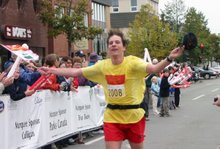
On the Run: Focus on training
Published on September 21, 2011
By Doug MacEachern
In today’s column I am going to focus at enhancing your training programs.
This topic may be of interest to those that looking to improve their Island Marathon times from previous runs, qualifying for the Boston or New York marathons or just becoming a little more fit and taking your running up a notch to the next level. I would like to thank Josh Clarke from Cool
Running.com for providing some of the following information and training tips.
While the specifics of every training program should be adapted to the specific needs of the individual, the runner interested in improving performance should have a well-rounded program that includes some, if not all, of the following six building blocks:
- Fartlek (for speed and pace)
- Hills (for strength)
- Tempo Runs (for speed and pace)
- Intervals (for speed)
- The Long Run (for endurance)
- Easy run (for recovery)
Variety is the key to improved speed and performance. While the majority of your running should remain in the realm of endurance training, the addition of building-block speed and strength workouts injects freshness into what may be a stale routine.
Varied workouts teach your body varied lessons. The long run teaches endurance, track work trains ‘fast-twitch’ muscles, hills teach strength, etc. A well-rounded mix of workouts will help you improve your running form, condition your body to handle the discomfort of faster speed, give you a sense of appropriate pace, and build your end-of-the-race kick to the finish.
While your training program should be suited to your goals, you will find that by adding at least some regular speed and strength workouts will improve your performance, with the most dramatic improvement occurring when you first begin your program.
Every single one of these building-block workouts will improve some aspect of your running, and the more you incorporate into your routine the more improvement you will see. That said, be aware it takes about two weeks for your body to absorb a speed workout and translate it into a resource to be tapped during a race.
Be patient, and don’t expect every session to show an improvement in times. The fitter you get, the more difficult that becomes. Always build conservatively.
If you are a beginning runner, you may want to hold off on introducing Interval speed work into your routine.
You should have an established base of at least 30 kilometres per week before incorporating these ‘quality runs’ into your schedule. It’s also recommended to have at least a year of running experience under your belt.
The reason for both is that speed work adds considerable strain to your muscles and connective tissues. Without the necessary mileage foundation, you may wind up injured rather than fast. But feel free to add other components into your routine.
As with all your runs, you should start and finish your specialized sessions with easy running.
With all of these workouts, you’re pushing your body close to its limits, and it’s unwise either to start or stop suddenly. Stretch well and give yourself 10 minutes of easy running, both before and after the workout.
Also keep in mind that it’s important to keep moving between the ‘hard’ portions of your workout. All of the workouts discussed here involve the alternation of hard and easy efforts. ‘Easy’ means a slow pace, maybe a jog. But it does not mean walking, stopping, or collapsing to the track and wheezing.
If you need to do any of those things, you’re running the hard portion of the workout too fast. The old adage of ‘no pain, no gain’ is simply wrong.
The idea is to push only a little bit harder than your normal training pace to get the benefits; there will be some modest discomfort but certainly no pain. You should always have the energy after each interval to continue running slowly during the rest periods. By doing this, you keep your heart rate up, and as a result, you prevent blood from pooling in your legs. Keep running, even if slowly. It’s good for you.
Ideally, you should run each of the hard portions of the workout at approximately the same pace throughout the session. You should not feel exhausted by the end, but neither should you feel like you’re still full of energy. This helps teach you the value of pacing yourself in a race by being aggressive but realistic in your starting pace.
Next time we will look at each fundamental in a little more detail and explain how we can introduce them into our training routines
Before I sign off, I would like to take a minute to recognize and tip my hat to two local runners Marion Grant and Kim Bailey. Both are the first Islanders to compete as soloists in two of the toughest runs in Canada if not North America, over the past two summers. The 125 k Canadian Death Race and the 148 k Sinister Seven, both these trail events are held in Alberta on rugged trails through and over the Rocky Mountains with elevations gains of over 34,000 feet.
Doug MacEachern is chair of course logistics for the BMO Nesbitt Burns P.E.I. Marathon. For questions about training, contact him at info@princeedwardislandmarathon.com




























No comments:
Post a Comment